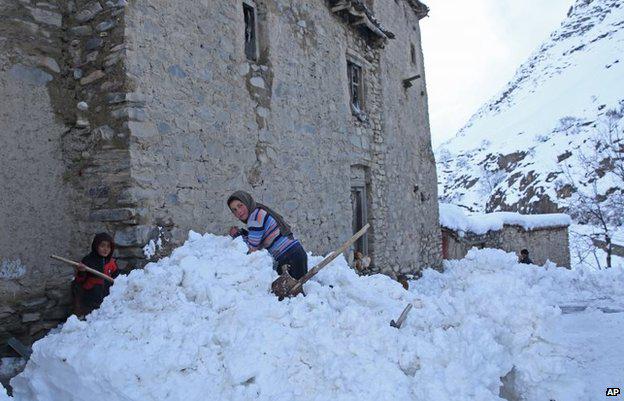
Afghan rescuers are searching for dozens of people believed to be trapped under snow after a series of deadly avalanches north of the capital, Kabul. Officials said at least 187 people had been killed and 129 injured after homes were covered in Panjshir province. They said the avalanches and sudden snowfall were the worst in decades, and took locals by surprise.
Although avalanches are quite common, this year’s disaster is the most deadly in years. Some 20 avalanches hit the Salang area in 2010, killing at least 165.
Many younger people tend to leave the Panjshir valley to find work in Kabul. They live in the capital, but may have houses in the valley that they visit occasionally, especially in the summer. It is the poorer, rural population who would be living there during the cold winter months. They tend to be farmers who are used to dealing with harsh winters, when roads are often blocked and their communities can be cut off. It is these people - about 60,000 of them - who are the most vulnerable to this kind of disaster, particularly because they live in mud-brick houses that are not designed to resist such forces.
Civilians and rescue teams were having to battle through snow-blocked roads to try to reach remote areas. Funerals for the victims in Panjshir province, usually held within hours of death, have been delayed because of the snow.
Afghan cricket officials dedicated their first ever world cup victory to the victims of the avalanches.
Other parts of Afghanistan have also been battling severe weather. In the far north-eastern province of Badakhshan, at least 11 people died in avalanches, officials told the BBC. And in Nuristan, officials said an avalanche buried a house, killing 14 members of the same family. Four bodies had been recovered, and emergency teams were trying to dig out the other 10.
本时文内容由奇速英语国际教育研究院原创编写,禁止复制和任何商业用途,版权所有,侵权必究!
1.What made local officials feel astonished?
A Dozens of people were trapped under snow.
B A series of avalanches happened north of the capital.
C The avalanches were the worst in decades.
D It suddenly snowed in the Salang area.
解析:选C。C 细节理解题。根据文章第1段最后1句They said the avalanches and sudden snowfall were the worst in decades, and took locals by surprise可知,这次雪崩和降雪是几十年来破坏力最大的,这让当地官员们非常吃惊。
2.Why do the young people visit their hometown occasionally?
A They spend winter in the valley as they are used to cold weather.
B They have houses in the valley while working in the capital.
C They are the poorer and rural population and have do live there.
D They are mostly farmers and have to go back to the valley.
解析:选B。B 细节理解题。根据文章第3段第2句They live in the capital, but may have houses in the valley可知,虽然他们在首都工作,但是在家乡有自己的房屋,因此还时不时回来看看。
3.What can we infer from the passage?
A The poorly constructed houses couldn't stand against avalanches.
B The farmers living in this area were easily attacked by avalanches.
C It was typical that the farmers live in mud-brick house in this area.
D Young people leave their hometown as they don’t like rural life there.
解析:选A。A 推理判断题。根据文章第3段最后1句particularly because they live in mud-brick houses that are not designed to resist such forces可以判断,居民们居住条件简陋,房舍建筑难以抵挡雪崩的冲击力。
4.What do we know from the last paragraph?
A Civilian houses across the country were not strongly built.
B Sudden heavy snow fell across the country.
C Other provinces of Afghanistan were suffering from harsh winter.
D Other places in Afghanistan were also stricken by avalanches.
解析:选D。D 细节理解题。综合Badakhshan和Nuristan遭遇灾害来看,阿富汗其他地方也遭受了雪崩的袭击。
5.What is the author’s attitude toward the young people from the valley?
A Sympathetic.
B Enthusiastic.
C Indifferent.
D Suspicious.
解析:选A。A 推理判断题。根据文章中的worst, vulnerable, poorer, rural等词汇可以判断,作者对于村民遭受雪崩袭击深感同情。